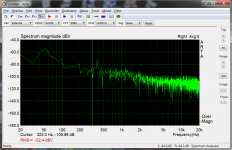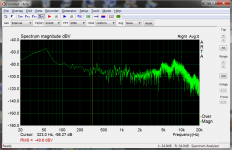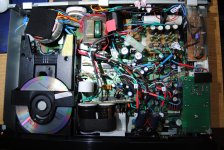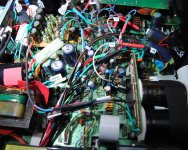Some residual hiss is normal, just like Ben says. This is a high-frequency left-over from the filter. But the sound you describe looks more like transformer induced rattling, caused by the magnetic field or charging spikes from the bridge rectifier. Moving the transformer away from the analog section will probably fix it.
Ray
Thank you Ray
Next move will be moving the several TX away from the output DOS.... External psu case probably.... nice
Hi Ricardo, can you record the noise, with your phone maybe? I got a hum, 50Hz one, and all answers here prompt me to subcase my DOS... BTW, a record please 😉
Will do.... just bought a microphone for that purpose.... but it will be later because today is my birthday and I am going to Lausanne to celebrate 🙂
50Hz hum can also be caused by a ground-loop, if it's a steady hum with no rattling.
It is steady :'(
Returning from the City with some nice feelings about it I got time to record the noise and also took some pics.
The "linear" graph is "home noise" with system speakers muted, the one with the bump between 5 and 10k is was recorded with the mic near the tweeter with the system full on without music.
The "linear" graph is "home noise" with system speakers muted, the one with the bump between 5 and 10k is was recorded with the mic near the tweeter with the system full on without music.
Attachments
Sounds normal to me. This level of noise will/should not be audible when playing music, not even if it's played loud. I've noticed a slight presence of hiss during very quiet passages while playing classical music quite loud. But it's hard to tell if it's coming from the player or from the recording.
in this case it is not normal because it is much stronger on the right channel (the one we are studying).
The noise can not be heard when playing "normal" music but it is clearly audible when playing Eric Satie on quiet passages at loud volume.
Anyway, I do not think it is hum.... and being only on one channel lets me believe it is magnetically induced.
PS: Using headphones (with my new headphone amp) it is quite intrusive.
I will post some pictures of the inside of the player so you can analyse it and maybe suggest the best way to correct this issue.
The noise can not be heard when playing "normal" music but it is clearly audible when playing Eric Satie on quiet passages at loud volume.
Anyway, I do not think it is hum.... and being only on one channel lets me believe it is magnetically induced.
PS: Using headphones (with my new headphone amp) it is quite intrusive.
I will post some pictures of the inside of the player so you can analyse it and maybe suggest the best way to correct this issue.
Oh, that's true, missed that one. If noise is stronger on one side, I'd suspect there's a filter components not properly connected. It could be as simple as one capacitor not being connected to ground, for example.
The noise doesn't surprise me, with all that spaghetti 😀
Just kidding, I think the problem is of analog origin and should be confined to the DOS board in this case. If you have a scope, you could measure around the filter stages and see if there's a difference between channels.
Just kidding, I think the problem is of analog origin and should be confined to the DOS board in this case. If you have a scope, you could measure around the filter stages and see if there's a difference between channels.
The spaghetti came from my initial intent to route all gnd wires to the star GND.....
Now I would have done it differently, but it is too late.
I will be looking at the DOS and it's dedicated psu.... 🙂
Now I would have done it differently, but it is too late.
I will be looking at the DOS and it's dedicated psu.... 🙂
Well, at least you're not suffering from hum, which indicates that your strategy works 🙂
The hiss is most likely an analog problem, I doubt that the DAC will give out different amounts of hiss for left and right.
The hiss is most likely an analog problem, I doubt that the DAC will give out different amounts of hiss for left and right.
Firstly, knowing the frequency of the noise would help locate the source. Secondly that wiring is an EMC nightmare of antennas and loops that could either transmit noise or pick it up. Finding the problem may not be easy.
Well, today I opened the machine, took out the rectifier board used for dac analog and digital that sits closer to the dos and powered it up... no change....
I did profit to solder some 47n styros over the output caps and sound is now much better... next time I will try moving the clock tx away from the dac and see....
I did profit to solder some 47n styros over the output caps and sound is now much better... next time I will try moving the clock tx away from the dac and see....
Firstly, knowing the frequency of the noise would help locate the source. Secondly that wiring is an EMC nightmare of antennas and loops that could either transmit noise or pick it up. Finding the problem may not be easy.
As per my arta pics, noise sits mainly between 5 and 10khz.... do you have a clue ?
- Home
- Source & Line
- Digital Source
- Marantz CD63 & CD67 mods list
 Happy birthday then!
Happy birthday then! 



